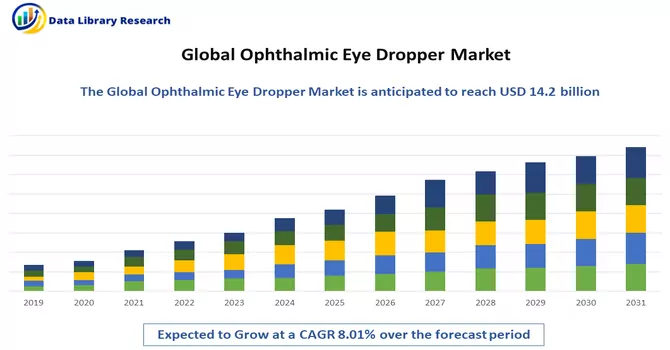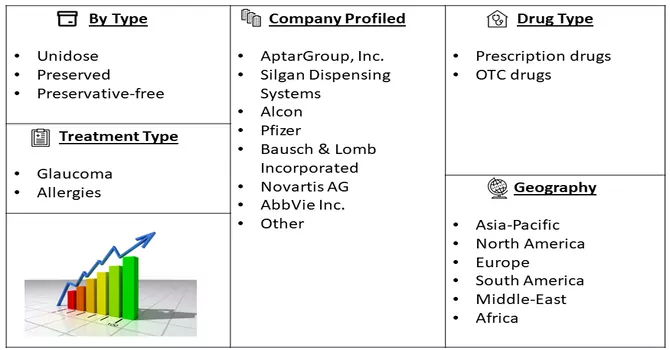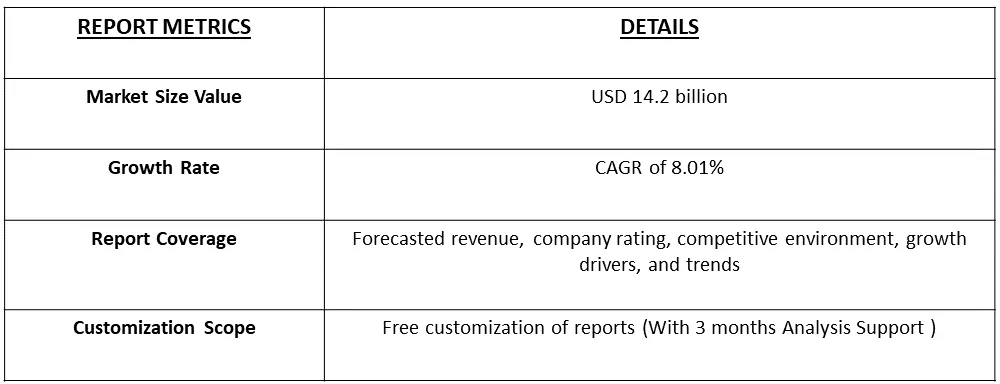The global ophthalmic eye dropper market size was estimated at USD 14.2 billion in 2023 and is anticipated to grow at a compound annual growth rate (CAGR) of 8.01% from 2024 to 2030.

Get Complete Analysis Of The Report - Download Free Sample PDF
An ophthalmic eye dropper, also known simply as an eye dropper or eye drop dispenser, is a medical device designed for the precise and controlled installation of liquid medication or solutions into the eyes. It is commonly used to administer ophthalmic medications such as eye drops, which are pharmaceutical formulations intended for ocular application. The eye dropper typically consists of a small, squeezable plastic or glass bottle with a narrow, pointed tip that allows for accurate dispensing of the liquid. The design of ophthalmic eye droppers ensures that the medication is delivered in precise drops, facilitating targeted application to the eye while minimizing wastage. These devices are widely used in the treatment of various eye conditions, including glaucoma, conjunctivitis, and dry eyes, among others. The use of ophthalmic eye droppers helps ensure proper dosage and effective delivery of medications for ocular health.
The ophthalmic eye dropper market is experiencing robust growth driven by various factors. The escalating incidence of ocular disorders, including glaucoma and dry eyes, coupled with advancements in ophthalmic medications, fuels the demand for precise and controlled drug delivery systems. The market is propelled by patient-centric healthcare trends, emphasizing user-friendly drug administration methods. The ageing global population, prone to eye conditions, contributes to increased adoption, while technological innovations in packaging enhance the safety and usability of eye droppers. Growing healthcare expenditure supports the development of advanced medical devices, including ophthalmic eye droppers. Heightened awareness among healthcare professionals and patients about accurate medication administration further drives market growth. Additionally, lifestyle-related factors, such as prolonged screen time, have led to an increased prevalence of conditions like dry eyes, fostering demand for over-the-counter and prescription eye drops and, consequently, ophthalmic eye droppers. With a focus on improving treatment outcomes and enhancing patient care in the field of eye health, the ophthalmic eye dropper market is poised for continued expansion.
Market Segmentation: The Ophthalmic Eye Dropper Market is Segmented By Type (Unidose, Preserved, Preservative-free), Drug Type (Prescription drugs, and OTC drugs), Treatment Type (Glaucoma, and Allergies), and geography (Europe, North America, Latin America, Asia-Pacific, and the Middle East and Africa). The market sizes and forecasts are provided in terms of value (USD) for all the above segments.

For Detailed Market Segmentation - Download Free Sample PDF
The market for ophthalmic eye droppers is experiencing notable trends that reflect the evolving landscape of eye care and pharmaceuticals. One prominent trend is the increasing focus on patient-centric designs and user-friendly features in ophthalmic dropper packaging, aimed at enhancing ease of use and ensuring precise dosage administration. The adoption of advanced materials and technologies, such as preservative-free formulations and innovative packaging materials, is gaining traction to address concerns related to product safety and ocular health. Additionally, there is a growing emphasis on the development of speciality eye droppers tailored for specific ophthalmic medications and conditions. The rise of digital health and telemedicine has spurred interest in home-based treatments, influencing the design of self-administration-friendly ophthalmic droppers to meet the demands of remote healthcare practices. As sustainability gains prominence across industries, including healthcare, eco-friendly packaging solutions for ophthalmic eye droppers are emerging as a significant trend. Furthermore, continuous advancements in pharmaceutical formulations for ocular treatments contribute to the ongoing evolution of ophthalmic eye droppers, aligning with the broader goal of providing effective and patient-friendly solutions in the field of eye care.
Market Drivers:
Increased R&D Investments In Ophthalmic Treatments Drive This Growth
The growth of the ophthalmic eye dropper market is significantly propelled by increased research and development (R&D) investments in ophthalmic treatments. Pharmaceutical companies and healthcare research institutions are directing substantial resources towards the development of advanced ophthalmic medications, driving the demand for specialized delivery systems such as ophthalmic eye droppers. The heightened focus on R&D is yielding innovative solutions for various eye conditions, including glaucoma, dry eyes, and other ocular disorders. This surge in R&D investments is not only fostering the discovery of novel therapeutic formulations but also influencing the design and functionality of ophthalmic eye droppers to ensure optimal drug delivery and patient compliance. As advancements in ophthalmic treatments continue to emerge, fueled by robust R&D initiatives, the ophthalmic eye dropper market is poised for sustained growth, offering patients more effective and targeted solutions for their eye health needs.
A Rise In Aging Population Base Worldwide Contributes To An Increased Prevalence Of Eye Disorders Such As Glaucoma, Cataracts, And Age-Related Macular Degeneration
The global increase in the aging population has become a significant factor contributing to the growing prevalence of eye disorders such as glaucoma, cataracts, and age-related macular degeneration (AMD). As populations age worldwide, there is a natural upsurge in the incidence of age-related eye conditions due to physiological changes in the eyes over time. Glaucoma, characterized by increased intraocular pressure, and cataracts, involving the clouding of the eye's lens, are more common in older individuals. Additionally, age-related macular degeneration, a leading cause of vision loss in the elderly, becomes more prevalent with advancing age. This demographic shift has spurred a heightened demand for effective and targeted ophthalmic treatments, including medications administered through specialized delivery systems like ophthalmic eye droppers. As the aging population continues to expand, the ophthalmic eye dropper market is poised to play a crucial role in addressing the specific healthcare needs associated with age-related eye disorders, contributing to the overall growth of the eye care industry.
Market Restraints:
Regulatory Compliance
The growth of the ophthalmic eye dropper market may face potential impediments due to regulatory compliance challenges. Stringent regulations and compliance requirements within the healthcare and pharmaceutical industries necessitate thorough testing, documentation, and adherence to standards for the approval of ophthalmic medications and their delivery systems. Meeting these regulatory demands often involves a rigorous and time-consuming process, which can potentially slow down the introduction of new ophthalmic eye dropper products to the market. The need for comprehensive safety and efficacy data, adherence to Good Manufacturing Practices (GMP), and compliance with regional and international regulatory frameworks may pose hurdles for manufacturers, impacting the pace at which innovations in ophthalmic eye dropper technologies can be brought to fruition. As companies navigate these regulatory complexities, addressing compliance challenges becomes integral to sustaining growth and ensuring the safety and efficacy of ophthalmic eye dropper products in the market.
The COVID-19 pandemic has had a multifaceted impact on the ophthalmic eye dropper market, introducing both challenges and opportunities. During the initial phases of the pandemic, disruptions in the global supply chain, lockdown measures, and reduced patient visits to healthcare facilities had a notable effect on the production and distribution of ophthalmic eye droppers. Many elective eye procedures were postponed, leading to a temporary decline in demand for certain ophthalmic medications and related delivery systems. However, the increased awareness of eye health and hygiene during the pandemic, coupled with the surge in screen time due to remote work and online activities, has fueled a growing concern for ocular health. This heightened awareness has driven the demand for eye care products, including ophthalmic eye droppers, as individuals seek relief from issues such as dry eyes and digital eye strain. Moreover, the emphasis on contactless healthcare practices has accelerated the adoption of telemedicine and home-based treatments. Patients are more inclined to use self-administered ophthalmic medications, including those delivered through eye droppers, as part of remote healthcare management. As the global healthcare landscape adapts to the ongoing challenges of the pandemic, the ophthalmic eye dropper market is expected to witness a resurgence in demand, driven by a renewed focus on eye health, increased acceptance of telehealth solutions, and the ongoing development of innovative pharmaceuticals for ocular conditions. The industry is likely to continue evolving as it navigates the dynamic interplay of healthcare trends and the lasting impacts of the COVID-19 pandemic on consumer behaviour and healthcare practices.
Segmental Analysis:
Preservative-free Segment is Expected to Witness Significant Growth Over the Forecast Period
The ophthalmic eye dropper market is witnessing a significant trend towards the adoption of preservative-free formulations, reflecting a growing concern for ocular health and patient well-being. Traditional ophthalmic medications often contain preservatives to prevent contamination, but these additives can cause irritation and allergic reactions in some individuals. As a response to this, there is a heightened demand for preservative-free ophthalmic eye droppers, particularly in the treatment of conditions such as dry eyes and glaucoma. Preservative-free formulations contribute to a reduced risk of adverse effects and offer a more comfortable experience for patients. This trend aligns with the broader industry focus on patient-centric approaches, emphasizing not only the efficacy of treatment but also the overall safety and tolerability of ophthalmic medications. As preservative-free options gain prominence, manufacturers in the ophthalmic eye dropper market are increasingly investing in research and development to provide innovative solutions that cater to the evolving preferences and needs of both healthcare professionals and patients.
OTC Drugs Segment is Expected to Witness Significant Growth Over the Forecast Period
The OTC (Over-the-Counter) drugs segment is playing a notable role in shaping the ophthalmic eye dropper market, contributing to its growth and diversification. Over-the-counter ophthalmic eye droppers, available without a prescription, provide consumers with convenient access to self-administered eye care solutions. This segment has witnessed a surge in demand for various conditions, including dry eyes, redness relief, and allergy-related eye symptoms. The accessibility and ease of purchase of OTC ophthalmic eye droppers cater to individuals seeking immediate relief from common eye discomforts. The OTC market's expansion is fueled by consumer preferences for self-directed healthcare and the growing awareness of eye health. Manufacturers in the ophthalmic eye dropper market are responding to this trend by developing a wide range of OTC eye drops, offering choices that address specific needs such as lubrication, allergy relief, and redness reduction. As OTC eye care products continue to gain popularity, the ophthalmic eye dropper market is set to witness sustained growth, driven by the convenience and accessibility provided to consumers seeking effective solutions for their eye care needs.
Glaucoma Segment is Expected to Witness Significant Growth Over the Forecast Period
Glaucoma, a chronic eye condition characterized by elevated intraocular pressure leading to optic nerve damage, plays a pivotal role in shaping the ophthalmic eye dropper market. As one of the leading causes of irreversible blindness, glaucoma necessitates consistent and effective intraocular pressure management to prevent vision loss. Ophthalmic eye droppers are a primary and often lifelong means of administering glaucoma medications directly into the eyes. The market for these eye droppers is significantly influenced by the prevalence of glaucoma globally. Given the chronic nature of glaucoma treatment, patient adherence is crucial, making the convenience and effectiveness of ophthalmic eye droppers paramount. The market has witnessed a trend towards the development of innovative formulations and delivery systems to enhance patient compliance and ensure precise dosage administration. Additionally, the integration of preservative-free options in glaucoma eye drops addresses concerns related to potential adverse effects, further contributing to the market's evolution. Ongoing advancements in glaucoma medications and sustained efforts to improve the efficacy of ophthalmic eye droppers highlight the industry's commitment to addressing the specific needs of glaucoma patients. As the ageing population grows and the prevalence of glaucoma rises, the ophthalmic eye dropper market is poised for continuous innovation to meet the evolving demands of glaucoma management and contribute to preserving the vision and overall eye health of individuals worldwide.
North America Region is Expected to Witness Significant Growth Over the Forecast Period
North America stands as a key region influencing the dynamics of the ophthalmic eye dropper market with its robust healthcare infrastructure, technological advancements, and a growing emphasis on ocular health. The prevalence of eye disorders, including glaucoma and dry eyes, has propelled the demand for effective ophthalmic treatments, thereby driving the market for eye droppers. The region's aging population contributes to an increased incidence of age-related eye conditions, further fueling the need for precise and patient-friendly drug delivery systems. Moreover, the North American market reflects a growing trend toward preservative-free formulations in ophthalmic eye droppers, aligning with the region's heightened focus on patient safety and preferences. Regulatory compliance standards and stringent quality control measures in North America contribute to the market's evolution, ensuring the safety and efficacy of ophthalmic medications. Technological innovations and a strong presence of pharmaceutical companies engaged in research and development activities further propel the growth of the ophthalmic eye dropper market in North America. The region's inclination towards advanced healthcare practices, including telemedicine, is influencing the design of user-friendly eye droppers for home-based treatments. As the North American population continues to prioritize eye health, the ophthalmic eye dropper market is expected to witness sustained growth, driven by ongoing developments in drug formulations, packaging technologies, and a commitment to addressing the specific healthcare needs of the region's diverse demographic.

Get Complete Analysis Of The Report - Download Free Sample PDF
The ophthalmic eye dropper market is predominantly shaped by key industry players that collectively dominate the market share and influence industry dynamics. A comprehensive analysis of the financials, strategy maps, and product portfolios of these leading companies has been conducted to map the intricate supply network within the ophthalmic eye dropper sector. These companies play a pivotal role in setting trends and driving innovation in the market. Through a meticulous examination of their financial performance, strategic approaches, and product offerings, a nuanced understanding of the supply chain dynamics has been achieved.
Recent Development:
1) In September 2023, the FDA granted approval to RYZUMVlTM (Phentolamine Ophthalmic Solution) 0.75% Eye Drops. These drops are designed to address pharmacologically induced mydriasis, a condition triggered by parasympatholytic drugs like Tropicamide or adrenergic agonists such as Phenylephrine.
2) In May 2023, Bausch + Lomb Corporation secured FDA approval for MIEBO (perfluorohexyloctane ophthalmic solution, formerly known as NOV03). This achievement marks a significant milestone as it establishes MIEBO as the first FDA-approved medication in the United States specifically tailored to alleviate the symptoms and signs associated with dry eye disease (DED).
Q1. What was the Ophthalmic Eye Dropper Market size in 2023?
As per Data Library Research the global ophthalmic eye dropper market size was estimated at USD 14.2 billion in 2023.
Q2. At what CAGR is the Ophthalmic Eye Dropper market projected to grow within the forecast period?
Ophthalmic Eye Dropper market is anticipated to grow at a compound annual growth rate (CAGR) of 8.01% over the forecast period.
Q3. Who are the key players in Ophthalmic Eye Dropper market ?
Some key players operating in the market include
Q4. Which Region is expected to hold the highest Market share?
North America region is expected to hold the highest Market share.
Data Library Research are conducted by industry experts who offer insight on industry structure, market segmentations technology assessment and competitive landscape (CL), and penetration, as well as on emerging trends. Their analysis is based on primary interviews (~ 80%) and secondary research (~ 20%) as well as years of professional expertise in their respective industries. Adding to this, by analysing historical trends and current market positions, our analysts predict where the market will be headed for the next five years. Furthermore, the varying trends of segment & categories geographically presented are also studied and the estimated based on the primary & secondary research.
In this particular report from the supply side Data Library Research has conducted primary surveys (interviews) with the key level executives (VP, CEO’s, Marketing Director, Business Development Manager and SOFT) of the companies that active & prominent as well as the midsized organization
FIGURE 1: DLR RESEARH PROCESS

Extensive primary research was conducted to gain a deeper insight of the market and industry performance. The analysis is based on both primary and secondary research as well as years of professional expertise in the respective industries.
In addition to analysing current and historical trends, our analysts predict where the market is headed over the next five years.
It varies by segment for these categories geographically presented in the list of market tables. Speaking about this particular report we have conducted primary surveys (interviews) with the key level executives (VP, CEO’s, Marketing Director, Business Development Manager and many more) of the major players active in the market.
Secondary ResearchSecondary research was mainly used to collect and identify information useful for the extensive, technical, market-oriented, and Friend’s study of the Global Extra Neutral Alcohol. It was also used to obtain key information about major players, market classification and segmentation according to the industry trends, geographical markets, and developments related to the market and technology perspectives. For this study, analysts have gathered information from various credible sources, such as annual reports, sec filings, journals, white papers, SOFT presentations, and company web sites.
Market Size EstimationBoth, top-down and bottom-up approaches were used to estimate and validate the size of the Global market and to estimate the size of various other dependent submarkets in the overall Extra Neutral Alcohol. The key players in the market were identified through secondary research and their market contributions in the respective geographies were determined through primary and secondary research.
Forecast Model
